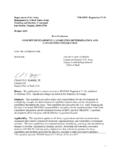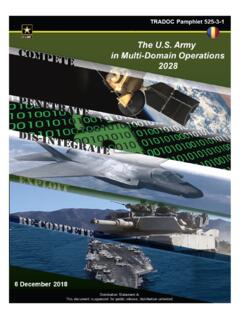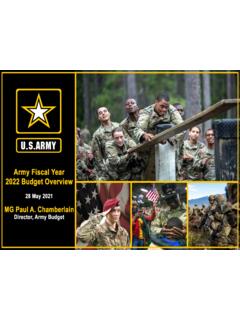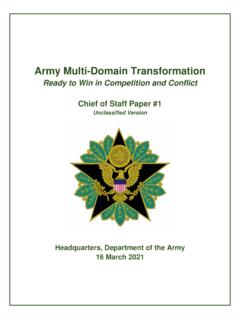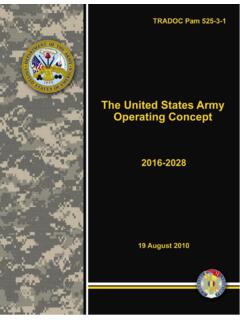Transcription of Multi-Domain Battle: Evolution of Combined Arms for the …
1 Multi-Domain Battle: Evolution of Combined arms for the 21st Century2025-2040 Version 2017 Distribution Statement for public release, distribution unlimitedThis page intentionally blank. i Foreword From the Commanding General, army Training and Doctrine Command The world is changing rapidly, and the operating environment is becoming more contested, more lethal, and more complex. Additionally, our peer adversaries are challenging the ability of the and our allies to deter aggressive actions. These changes are not new endeavors, but how we wage war, the speed and violence of armed conflict, and its global impacts are beyond anything we have seen in the past.
2 Over the last 20 years, our potential adversaries have studied our capabilities and developed the means to counter once-guaranteed domain overmatch. They have demonstrated asymmetric capabilities that deny our access to theaters, challenge the unity of coalitions, and negate freedom of action at the operational and tactical levels. Before this, it can be argued that the only had to deal with one contested domain the land domain . Ground forces operated with uncontested air, maritime, and space support, and for the most part cyber support.
3 Looking to the future, we will be contested in all domains and must be able to open windows of advantage for other domains from the land domain . Addressing these challenges demands a threat-based analytic approach that considers not only the military, but also intergovernmental and multinational partner contributions. This concept builds on the army Operating Concept and associated learning to identify how the army , working as part of the Joint Force, will operate against these peer adversaries to maintain interests, deter conflict, and, when necessary, prevail in war.
4 The purpose of the Multi-Domain Battle concept is to drive change and design for the future army . It will provide the foundation on which TRADOC conducts capabilities-based assessments to refine required capabilities, identify gaps, and determine potential capability and policy solutions for future forces. This document describes the future vision of the army and how we want to fight, while the more specific approach to fighting will be described in follow-on doctrine. Multi-Domain Battle necessitates that the view the operating environment, potential adversaries, and their capability sets from a different perspective.
5 We must define the warfighting problem based on the complexities of the modern battlefield, the rate of change in terms of information access and decision, and the role that non-traditional or proxy/hybrid actors play to shape operations, especially prior to armed conflict. Multi-Domain Battle requires the ability to maneuver and deliver effects across all domains in order to develop and exploit battlefield opportunities across a much larger operational framework. It must include whole-of-government approaches and solutions to military problems and address the use of multinational partner capabilities and capacity.
6 Multi-Domain Battle entails collaboration and integration of comprehensive effects and enablers. The rapid pace of modern conflict requires a mission command construct for executing Multi-Domain Battle that includes common networks, tools, and knowledge products. It also necessitates mission orders, shared understanding and visualization of the battlespace, and subordinate commanders executing operations with disciplined initiative within the senior commander s guidance that is empowered from above. Command and control is only a component of that philosophy.
7 To conduct Multi-Domain Battle, all domains and warfighting functions are integrated to deliver a holistic solution to the problem. Federated solutions will not work. We need a comprehensive, integrated approach inherent in our forces. The operational framework of the future is critical. Multi-Domain Battle extends the battlespace to strategic areas for both friendly and enemy forces. It expands the targeting landscape based on the extended ranges and lethality delivered at range by integrated air defenses, cross- domain fire support, and cyber/electronic warfare systems.
8 We must solve the physics of this expanded battlespace and understand the capabilities that each domain can provide in terms of echelonment, speed, and reach. Each Service's view of the operational framework will differ, but they are interdependent and must be viewed as such. Once we understand this future battlespace, we can begin to assess command and control re lat ionships and how we will execute Multi-Domain mission command. This document is the starting point to develop the future force capable of executing Multi-Domain Battle in competition and armed conflict.
9 Today the army and Marine Corps are working together to frame Multi-Domain Battle from the land domain 's perspective, and the army and Air Force are working together to understand the Multi-Domain Battle operational framework and key components required from the air domain . However, a comprehensive multi -service, interorganizational, and multinational engagement is lackin . As Multi-Domain Battle continues refinement, the community will do a better job workin ith our partners, including special operations forces, to build a cohesive, joi General, army Commanding ll Figure 1.
10 Multi-Domain Battle Logic Chart iv Applicability. This document applies to all Department of the army (DA) activities that develop doctrine, organization, training, materiel, leadership and education, personnel, and facilities (DOTMLPF) capabilities. It guides future force development and informs the Joint Capabilities Integration and Development System process. It also supports the army capabilities development processes described in TRADOC Regulation 71-20 and functions as a conceptual basis for developing supporting concepts related to the future force within DOTMLPF.
